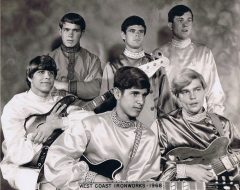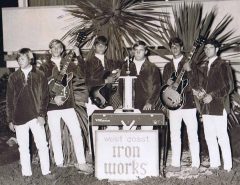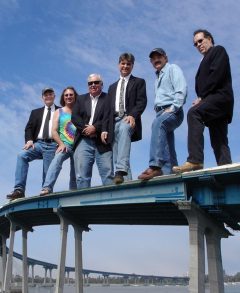Yesterday And Today
West Coast Iron Works Celebrates 50 Years

The West Coast Iron Works in 1968, from top left, clockwise: John Chambers, Gary Maltby, Dave Vaughan, Gary Carter, Bob Mansueto, and Richie Heinz

They began as a sign of the times – a small, high school rock ‘n roll band in the late 1960s. Before long the West Coast Iron Works had become a highly polished, award-winning ensemble, performing throughout Southern California, with regular appearances on KOGO’s Corner (hosted by Regis Philbin).
Now, 50 years later, the Iron Works celebrates a milestone. They will commemorate their 50th anniversary with a series of private performances, culminating with a free concert at McP’s Irish Pub in Coronado, Sunday, July 23, from 2-6 p.m.
In the mid-1960s the Iron Works perfected performing what is now revered as the first generation of classic rock ‘n’ roll. Today they continue to perform their legendary five-part vocal harmonies as a six-piece rock band, playing for a variety of corporate gigs, reunions, weddings and public concerts.
Gary Carter, aka “The Professor,” probably has the clearest memories from those early years. Carter plays 12-string rhythm guitar and sings back-up vocals with the Iron Works. He is a teacher by trade and a music historian by choice.
“I always considered it a real privilege to be in that group,” said Carter. “This was one of the most special things of my life and that’s why I remember it so well. For them, I suspect it was a casual experience. For me it was an obsession.”
An early inspiration to the band was Coronado High School teacher and bandleader, Bob Demmon. A former lead guitar player and vocalist for The Astronauts (1963, one-hit wonder), he continued to make appearances with the band up until his death from cancer.
Carter remembered how the band came together as students, and former students at Coronado High School. At the time, there were a variety of small rock bands performing around town — groups like the Towne Cryers, the Rubber Band, the London Beats, the Family Jewels and the Cubic Feet.
Just as cream rises to the top, eventually the best of the best in those bands found each other to form the West Coast Iron Works.
Carter stressed there was a chemistry unlike that found in any of their other bands. “We practiced virtually every day,” he said. “By the end of the second week we began to coalesce, and intuitively knew which harmony parts to sing.”
The first song they learned was “1941 Mining Disaster,” by the Bee Gees. “It was completely non-danceable,” said Carter, “but we loved it because the chord progression was complicated, and it required four-part harmony.”
They studied and absorbed until they became one with the music. They did this by listening and learning every note from old Vinyl recordings — carefully lifting the needle and playing certain parts over and over again. Of course, they attended as many rock concerts as they could, studying up close such musical groups as the Doors, Jefferson Airplane, and Cream.
Their first job was at the wedding of the bass player’s sister — at the Officers’ Club on North Island Naval Air Station. They wore corduroy jackets and ties. They only had ten songs but just kept replaying and stretching their set list. In the retelling of the story all these years later, they joke that “8 Miles High” became “800 Miles High.”
The Iron Works seemed to dominate the music scene from the very start. Great band battles were held and they won them all.
In 1968, one of their early road gigs was at the Swallows Sun Island Club, a country club of sorts located way out on Harbison Canyon Road — a long way from quiet little Coronado. They had to take the ferryboat to get across the bay.
As the members pulled up in their caravan of cars and equipment van loaded with roadies, a man at the gate stepped out to greet them. “He was stark raving naked,” said Carter. “It seems we had accepted a gig at a nudist camp.”
The multi-talented Gary Carter, who has been with the band since Day-One. Today he prides himself on being the band’s historian. He has boxes and boxes filled with memorabilia from the past 50 years of music. Gary still lives in Coronado and still plays music.
Richie Heinz, the bass player and vocalist, recalled that it was twilight when the band set up outside next to the dance floor and pool. “By the time we began performing, hundreds of naked people of all ages and shapes descended on the place.”
There was nothing they could do but keep playing. Eventually two of the band members adopted the dress code of the evening, and the music played on. Heinz remembers when the gig ended, the entire band stripped down and jumped in the pool. “It just seemed the natural thing to do,” he said.
Meanwhile, back in Coronado, the band’s reputation began to skyrocket. They performed regularly at the Coronado Municipal Pool, the Coronado Woman’s Club and the Coronado High School Gymnasium.
They created a unique event, called a “Be There” concert that took place on deserted marshland between Coronado and Imperial Beach along the Silver Strand. In theory, it was far from the maddening crowd (adults) and they could play as loud and as long as they liked. No one was there to check ID cards.
The concert venue was the Hog Ranch and Coronado’s rubbish site. Large mountains of garbage and wrecked cars sat everywhere in that undeveloped area, and dirt paths spider webbed throughout the compound.
“Be There” events involved a flatbed truck with a generator, music by the Iron Works, and all the keg beer and rocket fuel you could drink. The latter was a concoction brewed in large quantities of Kool-Aid, cheap red wine, sugar and 192 (pure alcohol). Dixie cups of the brew sold for one dollar.
The only light was provided from the truck’s headlights, but everywhere you looked there were high school kids dancing to rock ‘n’ roll and downing rocket fuel, four-ounces at a time.
Those “Be There” concerts were always outdoors. Often it was foggy, which made the sound a bit muddy. The intrusive odor of the dump, combined with the smell of smoke from the burning garbage (and the smell of marijuana), filled the air. It was, of course, just another sign of the times — the 1960s.
Today, the old Hog Ranch and dumpsite are home to Loews Coronado Bay Resort and the Coronado Cays — 1,200 multi-million dollar homes with private boat docks.
At that time, it seemed there were two societies in America. There was the Greatest Generation, as it has been rightfully tagged; and then there was the next generation of free spirits spawning from San Francisco’s Summer of Love.
In 1969 students were being expelled from high school for having long hair. Rock ‘n’ roll bands, perceived as “artists,” seemed to find a way to express themselves and still stay in school. They always lived on the edge when it came to their hair, their clothes, and the way they acted on stage (and off).
The West Coast Iron Works was no exception. Their popularity grew exponentially as the ‘60s turned into the ‘70s, and their musical performances were considered some of the best on the West Coast – the next best thing to the original artists, as review after review exclaimed.
Their particular music celebrated, and continues to celebrate, that special era of rock ‘n’ roll that included bands such as the Doors, the Animals, Buffalo Springfield, Cream, Jimi Hendrix, the Beatles and Rolling Stones, the Byrds, Moody Blues, Steppenwolf, the Jefferson Airplane and many more.”
The band competed in the KGB Battle of the Bands — a regional, antique car show with a music theme, hosted by the popular FM radio rock station. The West Coast Iron Works won with a 30-minute playlist of psychedelic tunes that included “Light My Fire,” “Born To Be Wild,” and “Eight Miles High.”
They destroyed the competition and for six months following, the band was heralded in newspapers and on television. They were the talk of the Southern California music world. Not surprisingly, the music gigs began to roll in.
The next year they won Ozzie’s Music Company’s Original Song Contest. That led to an appearance on KOGO’s Corner, hosted by Regis Philbin, with subsequent return visits to the show.
“That was the first and only time the band had to lip sync to a pre-recorded song,” said Heinz, who says what he remembers most is his meeting sexy TV show hostess Elvira backstage.
As their reputation grew, the West Coast Iron Works began to travel further and more often. They performed at scores of events from Southwestern College to San Diego State University; from the University of Southern California in Los Angeles to the University of California Santa Barbara.
Once they performed in the middle of Watts, not long after the infamous riots. The Santa Barbara gig was just months before protesters burned the Bank of America near Santa Barbara. Both of those events served as further illustration of the sign of the times.
“It seemed the experiences and adventures would never end,” said Heinz.
After that first year, various incarnations of the band had settled in. Founder and original drummer Artie Battson went away to college and then, replacement Charlie Wilhoit married and left. In 1968 the group was very fortunate to find drumming phenomenon Dave Vaughan, who immediately joined the Iron Works.
THE PLAYERS
The band rapidly took the shape of six very talented musicians. There is ruggedly handsome John Chambers (keyboard/vocals); and the proverbial boys-next-door, Bob Mansueto (lead guitar/vocals) and Dave Vaughan (drums/vocals).
Gary Carter, the token blonde in the group, was the silent type but nonetheless a lanky heartthrob on the rhythm guitar. He has become the band’s historian.
Gary Maltby, being the lead singer, had a fan club all his own. But Richie Heinz, the bass guitar player and vocalist was, without a doubt, the Little Joe Cartwright of the band.
“Every woman wanted him, every man wanted to be him,” said Carter, laughing at the memory of those early days.
Heinz, Carter and Vaughan all stand well over six feet, but it was their musicianship that set them apart. Vaughan was voted most talented in the Class of ’67 Coronado High School yearbook; Heinz was voted most talented in the Class of ’69 yearbook — more evidence of their popularity at the time.
Carter went on to become a professor and college dean, and continues to teach. He worked his way through Weber State University in Ogden, Utah, playing music in bars and with a multitude of bands. In those days, as a longhair from California, he was received as an immediate rock star in the tame confines of Utah.
In college, Heinz’ original songs attracted a financial backer. He and Vaughan then moved to San Francisco to play with a number of high-octane, original hard rock bands. They received considerable press coverage, which led to their performing throughout the ‘70s with an array of famous rockers indigenous to that region and time.
Heinz returned to San Diego in 1980 to help form the Heroes, a well-known staple on the San Diego music scene. In 1997 he helped found the Celtic group, Highland Way, recording and touring nationally while overwhelming his audiences with that deep and resonant voice. He performed with the San Diego Opera Chorus in 2004, in Wagner’s “Tanhauser,” and is a piano technician and tuner in his spare time.
Vaughan now sells real estate. He has performed in many popular bands since moving to Idaho, and returns often to make cameo appearances with the Iron Works.
Mansueto turned to jazz and recorded an album. He received lots of airtime on KIFM, San Diego’s Smooth Jazz radio station. He started Silver Strand Productions and Silver Strand Recording Studio before focusing on dentistry. He is never far from his guitar and frequently performs at area churches.
Maltby became a very successful marketer and had his own business for 30 years, catering to the surf and ski industry. He invented the miniature huarache sandal keychain as a marketing gimmick, and the original sunglasses holder (head string). He has become an accomplished abstract painter and continues to hit the high notes with the West Coast Iron Works. He sings with a variety of bands in South Orange County, and just started a trio (piano and guitar) called Amour.
Chambers has been in some major groups and performs on stages throughout the USA and abroad. In the military he played lead guitar in the official US Army Rock ‘n’ Roll Band. He’s a mainstay of the Bayou Brothers, among other bands. He is a household name in the music world, known for his outstanding vocals and musicianship.
Over the years there have been members of the band who have come and gone. Many, influenced by the tightly constructed harmonies and focused interplay of the Iron Works, went on to greatness in their own worlds.
An early Iron Works contributor on lead guitar was Danny Orlino. He continues to play and sing, and moved from Coronado to become the most famous resident of Guam — even more than that territory’s governor. “He’s the Don Ho of Guam,” said Carter.
Billy Thompson, also a Coronado High School grad, heard the Iron Works perform in the high school gym as a kid. He was so impressed he bought a guitar, and virtually took that guitar and locked himself in his room for a year.
Today he has multiple albums to his credit and performs with the greatest blues acts, touring the country, but always returning to Coronado to perform cameos with the Iron Works. He has also played at the SD Blues Festival and Humphrey’s Concerts By The Bay.
“Those guys were awfully good,” said Thompson of the Iron Works. “They taught me a lot, and to this day it’s really a pleasure to perform with them – to see their attention to detail in performing those first generation rock ‘n’ roll songs.”
Others who have performed as West Coast Iron Works members include Dougan Richardson. Bill Blair, Paul Castellanos, Jack Laux, Dave Shoudy, Randy Jones, Bruce Sharp, Will Beauchamp and George Nelms.
Four of the six original members remain at the core of the West Coast Iron Works — Maltby, Heinz, Carter and Chambers. Joining them since 2007 are San Diego rock icon Dave Gilbert on lead guitar/vocals, and Ric Lee on drums. Lee also performs with the Bayou Brothers, is a local music promoter, and has been a major contributor to the West Coast Iron Work’s continued success.
Over the decades, Iron Works musicians have played with or shared the bill with such artists as Gary Puckett, Elvin Bishop, the Chambers Brothers, Grace Slick, Journey, Buddy Miles, Freddy King, Albert King, Johnny Winter, Edgar Winter, Buddy Guy, Boz Scaggs, the Neville Brothers, Taj Mahal, the Ink Spots, the Drifters, BB King, the Steve Miller Band, and more.
The band has become the official Coronado All-Class Reunion Band as well, performing every July 3rd at the Coronado Golf Course, for thousands of former Coronado High School students who rally on that date annually to celebrate memories and old friends.
Now, 50 years later, it’s easy for Carter to reflect on the band’s challenges and victories, and what made them so good. “Everyone was such a perfectionist in the Iron Works,” he said. We figured every minute of stage time was the equivalent of 1-3 hours of rehearsal time. A 50-minute set then becomes the result of a minimum of 50 hours of rehearsal to get us to that point.
“The legacy of the Iron Works is that the band is still alive 50 years later and still getting along with each other. We like each other, and we love the music we play. We’ve all discovered this great sense of community and fellowship in getting together, whether it’s to practice or play a gig. I consider myself the luckiest person on the planet to have been on that train with the West Coast Iron Works these many years.”
The band will perform at Coronado High School reunions June 30 and July 3. They will ride in the Coronado July Fourth Parade, performing from the back of a truck bed. Their 50th Anniversary party will take place on the outdoor patio at McP’s Irish Pub on Sunday, July 23, from 2-6 p.m. and is free.
Their motto is “Music for all occasions.” Not just a ’60s time portal, the Iron Works excels in music from all decades and can custom tailor song lists upon request. That variety of music has increased their opportunities to perform.
As word of the West Coast Iron Works has once again begun to grow, their performance calendar boasts corporate gigs, music concerts, weddings, reunions and house parties. The latter has become quite popular as it allows the musicians to interact with the audience with fun memories from the 1960s.
For more information, please contact Rich Heinz, at 619-997-3713, or bajarichie@gmail.com; or Veronica or Karen, at 619-206-4000, or Karmalee42@gmail.com.







